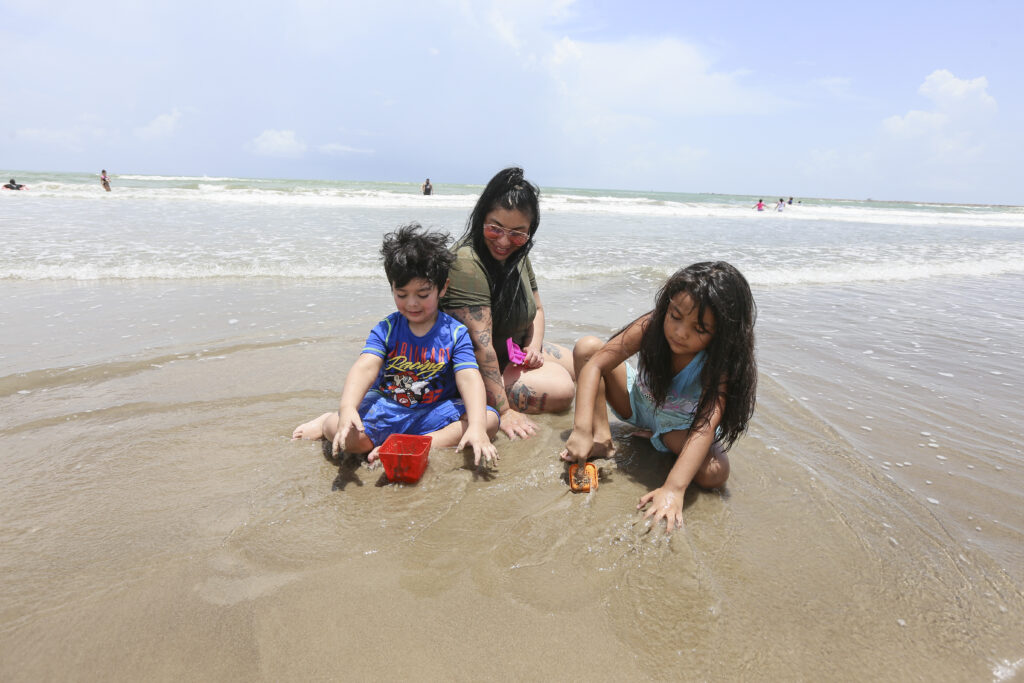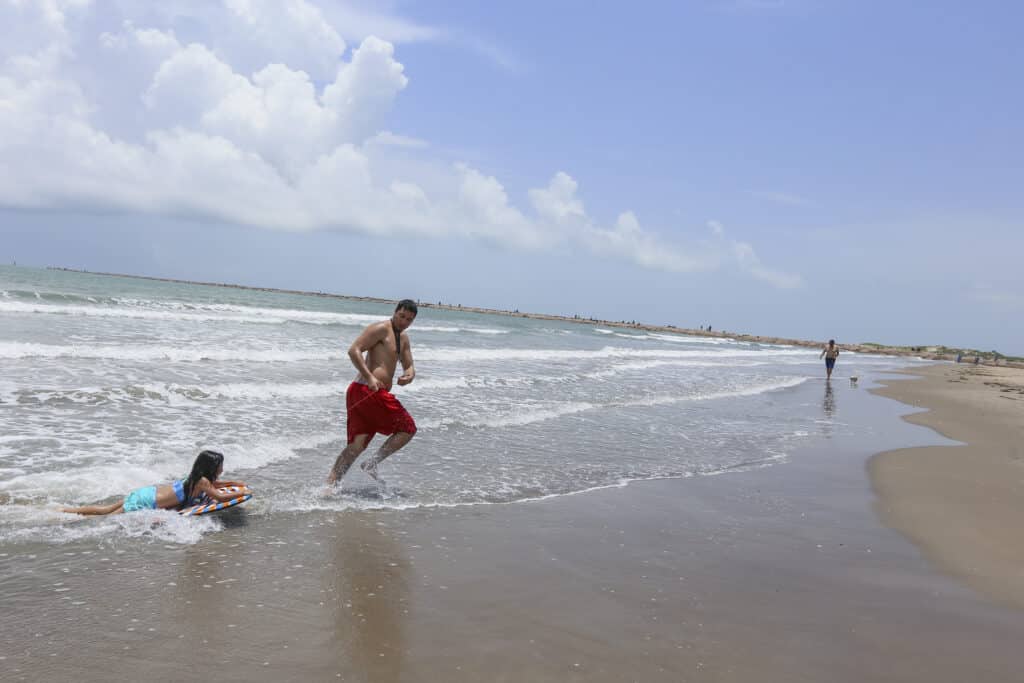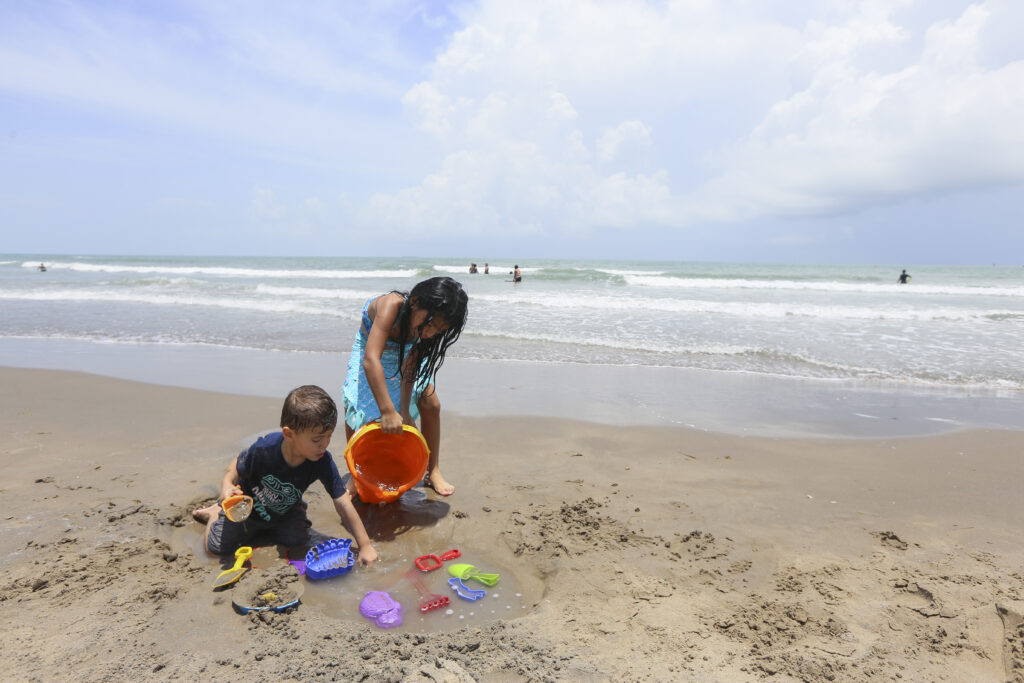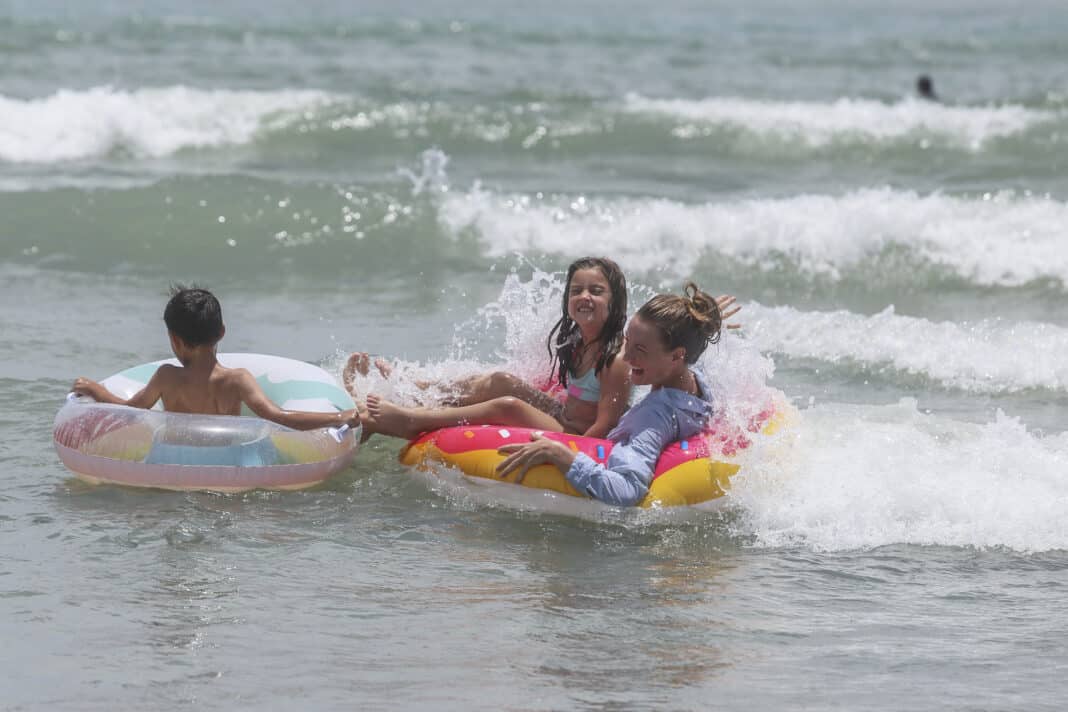As more families head to Texas beaches this summer, some beachgoers might return from vacation with an unfortunate waterborne illness.
An annual report recently published by Environment Texas warns that pathogens pose a threat to swimmers at 90 percent of Texas beaches. Yet, Cameron County’s beaches stood out as the safest in the state.
Last year, 55 out of 61 beach locations monitored by Texas Beach Watch for fecal indicator bacteria were potentially unsafe for swimming on at least one day, according to the “Safe for Swimming” report, an annual analysis conducted by the Environment Texas Research and Policy Center that was released July 1.
Whenever fecal indicator bacteria levels exceed the U.S. Environmental Protection Agency’s most protective “Beach Action Value,” an estimated of 32 out of every 1,000 swimmers are sickened, according to the report.
Some locations are of special concern. Environment Texas cited Cole Park Beach in Corpus Christi as having measured bacteria levels above that safety threshold on 91 percent of days tested in 2020.
In contrast, the safety threshold was breached 3 percent of the water-testing days in Cameron County — the only Texas county recording a single-digit percentage, making local beaches the safest in the state, statistically.
Galveston County followed Cameron County with 22% of days with potentially unsafe water for its beaches; Aransas County was at 31%; Nueces County was at 34%; Matagorda County was at 45%; San Patricio County was at 47%; Jefferson County was at 53% Brazoria County was at 56%; and Harris County topped the list of counties at 61%.

“Fecal contamination makes beaches unsafe for swimming,” states the executive summary of the “Safe for Swimming” report. “Human contact with contaminated water can result in gastrointestinal illness as well as respiratory disease, ear and eye infection, and skin rash.”
The problem extends well beyond Texas’ borders: Along the entire Gulf coast, 82% of monitored beaches reached potentially unsafe bacterial levels in 2020, the report stated.
Annually in the United States, swimmers contract an estimated 57 million cases of recreational waterborne illness from the nation’s oceans, lakes, rivers and ponds, according to the report.
“This includes cases of acute gastrointestinal illness,” Environment Texas stated via email.
Why are Rio Grande Valley beaches so much cleaner than the rest of the state’s coastal getaways?
“I know Corpus Christi has had chronic problems with leaking sewage pipes (affecting) their beach water quality,” said Luke Metzger, Executive Director of Environment Texas Research and Policy Center. “And that’s just been going on for, I think, decades now—and so it might just be the absence of such a problem for the Brownsville and South Texas coast. Those would just be guesses.”
The relatively lower population surrounding South Padre Island and Boca Chica Beach factors into keeping the coastal waters cleaner here as compared to other areas, such as around Galveston, said John Breier, a bio-geo chemist and associate professor with the School of Earth, Environmental, and Marine Sciences at the University of Texas Rio Grande Valley.
However, there are a number of factors involved, he explained.
“There’s really not just one reason,” Breier said. “We don’t always know for sure why some areas fare better than others, because there’s a lot going on.”
Officials test for fecal indicator pathogens, which are easier to measure than other possible contaminants, Breier said. “The main source of those pathogens of fecal indicators is feces, and that can come from a variety of places—wastewater, in particular.”

Sources of pollutants can include effluent and untreated waters or runoff from ranch land, farm land or urban areas that reach a river and flow into the Gulf of Mexico. In the Rio Grande Valley, the two main tributaries to the coastal water include the Rio Grande and the Arroyo Colorado, and when the region experiences storm events, the flow from those sources can have an increased impact on the Laguna Madre and areas around Boca Chica Beach and South Padre Island.
“The main difference from my understanding is that we are in a part of the Texas coast where the population is lower,” Breier said. “So broadly speaking, there’s just less wastewater coming in to this area.”
The area benefits when less river water mixes with the ocean water at the beach sites.
“All the rivers to the north of us, all of them, everywhere, have progressively more and more water flowing into the beach areas than we do here,” Breier said. “The water we are seeing at the beach is very much like offshore Gulf water.”
A body of water’s quality is sometimes noticeable in its appearance.
“We see this when we go to the beach here and see that the water is a prettier color, right? Sometimes, it’s a little turbid, but it’s generally kind of a green, sometimes a turquoise, sometimes a blue color. That’s an indicator of how much suspended material is in there.”
In short, the clearer the water, the less contaminants are in the water, typically.
However, that can change in the aftermath of a storm—especially during periods of heavy rainfall and flooding that swell the Rio Grande and push more contaminants from runoff toward the beaches.
Data from the International Boundary and Water Commission indicate the Rio Grande’s flow at Brownsville measured 3.68 cubic meters per second on July 2. Heavy rainfall in the following days resulted in river flow increasing there to 101.4 cubic meters per second on July 12. Two days later, on July 14, four testing locations nearest to the mouth of the Rio Grande on Boca Chica Beach registered high levels of fecal indicator bacteria, according to the Texas General Land Office’s Texas Beach Watch website (www.texasbeachwatch.com).
Further from the river, testing locations on South Padre Island remained at safe levels.
In agreement with Breier, South Padre Island Convention and Visitors Bureau Director Ed Caum also attributes the relatively cleaner local water conditions, in part, to less runoff water pollution locally than experienced elsewhere. “You know, I came here from Florida, and a lot of it is from runoff. We’re really blessed that we don’t have that here,” he said.
“We also don’t have a lot of ranching or farming directly around us, so that’s part of it.”
Those conditions stymy other areas of Texas more so than in Cameron County.
“Bacteria levels in Galveston Bay are safe for swimming most of the time,” said Charlotte Cisneros, community programs manager at Galveston Bay Foundation. “However, there are typically spikes in bacteria concentrations following major rainfall events. This is due to runoff carrying bacteria in to the bay from a variety of land sources, such as failing septic systems, pet waste and livestock.”
Regardless of the factors that have influenced Cameron County’s successes so far, South Padre Island’s marketing efforts bank heavily on a reputation for cleaner beaches and water.

“The sustainability of the beach is critical to the success of the island,” said Ed Caum, director of the South Padre Island Convention and Visitors Bureau. “There are other things to do on the island, but we are known as Texas’ best beach.”
Caum said people can help keep the beach and surf clean by picking up trash and cleaning up after pets.
“We have a lot of signs out, reminding people to pick up (litter and trash) and all of that,” Caum said, “because we want to be the most-pristine beach in Texas.”
Breier agrees that individuals can help combat water contamination by being good stewards of coastal lands and resources.
“If people enjoy the fact that our local water quality is good and enviable and would like to help keep it that way, they can help by encouraging everyone to reduce litter in the first place, picking up when they finish at the beach, including after their pets, and participating in the periodic beach cleanups,” Breier said. “Many people already do these things but the more the better.”
Meanwhile, Environment Texas is calling on the state and nation’s policymakers to take action— and make major investments — to reduce urban runoff pollution, prevent sewage pollution and reduce manure pollution that contribute to elevated fecal indicator bacteria levels at Texas beaches.
The organization is keeping watch on H.R. 1915, a bipartisan bill named the “Water Quality Protection and Job Creation Act of 2021,” which was introduced March 16 and approved by a U.S. House infrastructure committee on June 22. The bill awaits consideration by the full House of Representatives but calls for the investment of more than $50 billion in clean water infrastructure, including funding for projects that would directly affect the quality and safety of coastal waters.
“Even as Texans are back to enjoying the fresh sea breeze and splash of waves at the beach, pollution is still plaguing too many of the places where we swim,” Metzger said. “Now is the time to fix our water infrastructure and stop the flow of pathogens to our beaches.”
MORE INFORMATION:
For the latest water-quality levels, log on to www.TexasBeachWatch.com.




